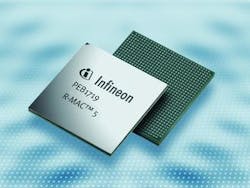Infineon IC enables voice, video and data services delivery over Ethernet
November 4, 2004 Munich, Germany -- Infineon Technologies AG has announced the new R-MAC family of ICs. Designed to improve Resilient Packet Ring (RPR) functionality in MANs, the RPR media-access-control (MAC) implementation features a channelized architecture to support multiple physical or virtual rings.
The single-chip R-MAC5 is the first member of the R-MAC family. It is a standards-compliant 5 Gbit/s RPR MAC allowing better integration of the benefits of RPR into SONET/SDH rings by supporting up to five rings in a complete RPR node. According to Markus Schaefer, product marketing manager for Layer 2 and 3 products at Infineon, the new device halves the number of chips previously required to support a node as well as offering the ability to support the five rings, which may have any combination of traffic speeds that aggregate to 5 Gbits/sec (2.5 Gbits/sec in each direction).
In addition, the new IC is the industry's first offering channelization, allowing telecom providers to create virtual RPR rings over the same physical ring and to use RPR technology as an overlay to existing SONET/SDH-networks. The built-in channelization and traffic-provisioning capabilities of R-MAC reduce capital and operations expenditure of telecom and service providers and enable them to manage and individually bill new revenue-generating Ethernet-based services to their customers. Main applications for R-MAC5 are next-generation add/drop multiplexers (ADMs), multiservice provisioning platforms (MSPPs), multiservice transport platforms (MSTPs), edge and core routers, Ethernet aggregation switches, and Ethernet passive optical network optical line terminals (OLTs). Schaefer says that he expects the first three platforms to provide most of the IC's initial applications.
The architecture of the device opens the door to other channelized ICs at different line rates. Schaefer suggested that both aggregate 10-Gbit/sec and 2-Gbit/sec devices would make sense, with the latter proving more popular. He noted that while the company's earlier FREA RPR device integrated the MAC and framer functions, the R-MAC family likely will not, due to Infineon's expectation that RPR MACs will find increasing use in purely Ethernet architectures. The device also is optimized to work in MPLS environments.
Sample quantities of the device are available now. Schaefer predicted that production would begin in either the latter stages of Q1 or the beginning of Q2 next year.
"SONET/SDH and Ethernet are the de facto standards for transport connectivity in the metro and transport market. There is a tremendous push from service providers to offer new Ethernet-based services that are flexible to manage and fit into the existing network infrastructure. We envision RPR as a key technology that allows Service Providers to efficiently transport these new Ethernet Services over their networks," said Christian Scherp, vice president and general manager, Wireline Communications Business Group, Infineon Technologies North America, in a press release.